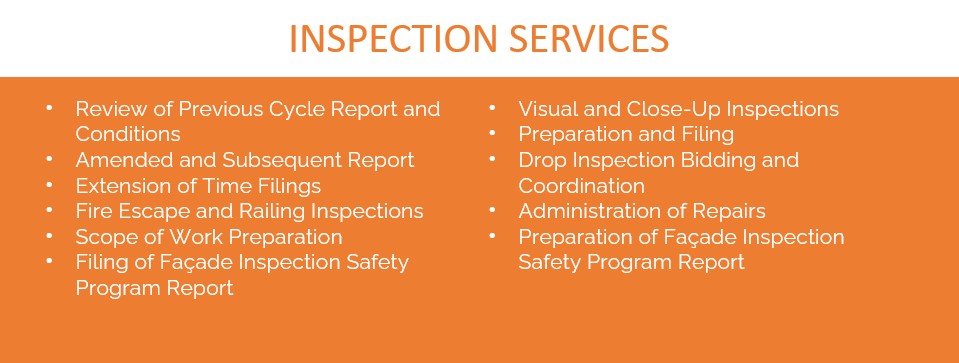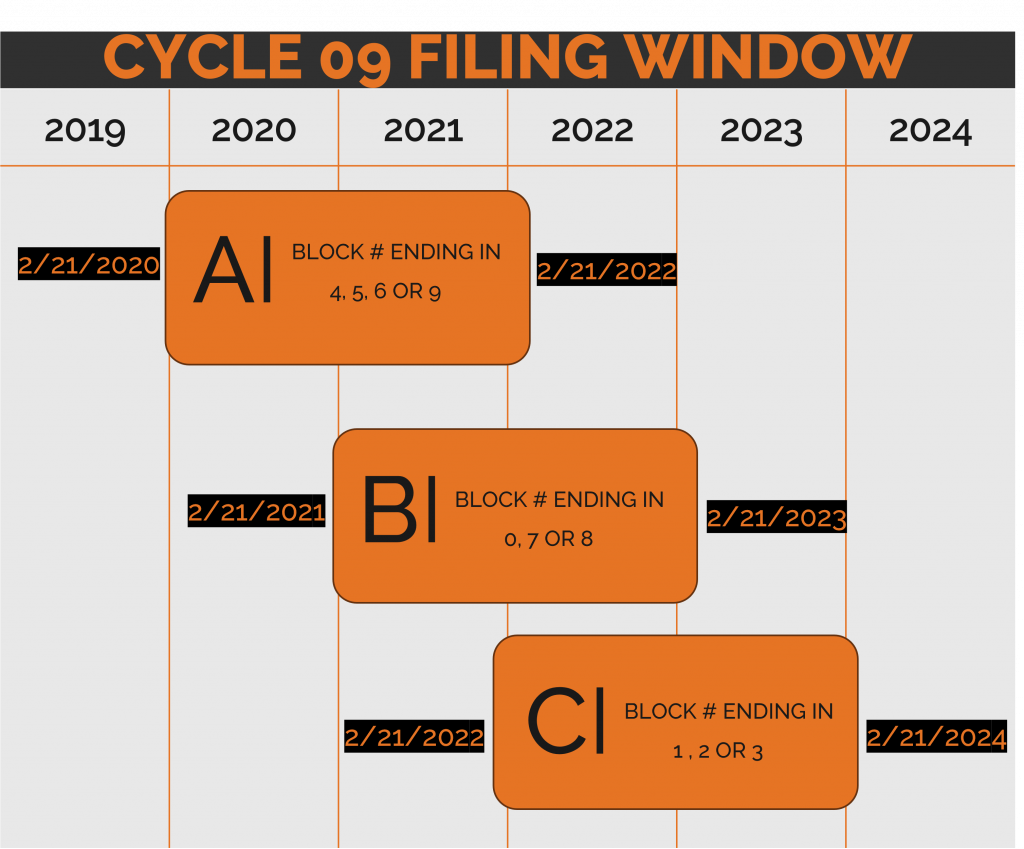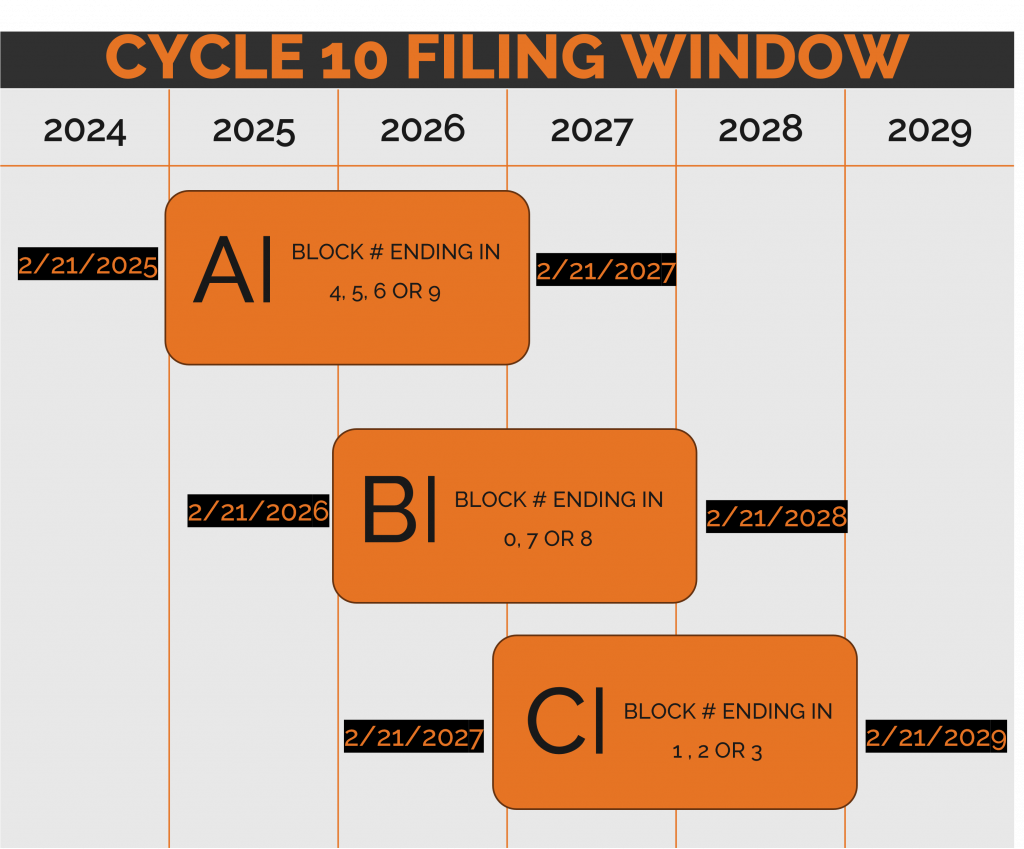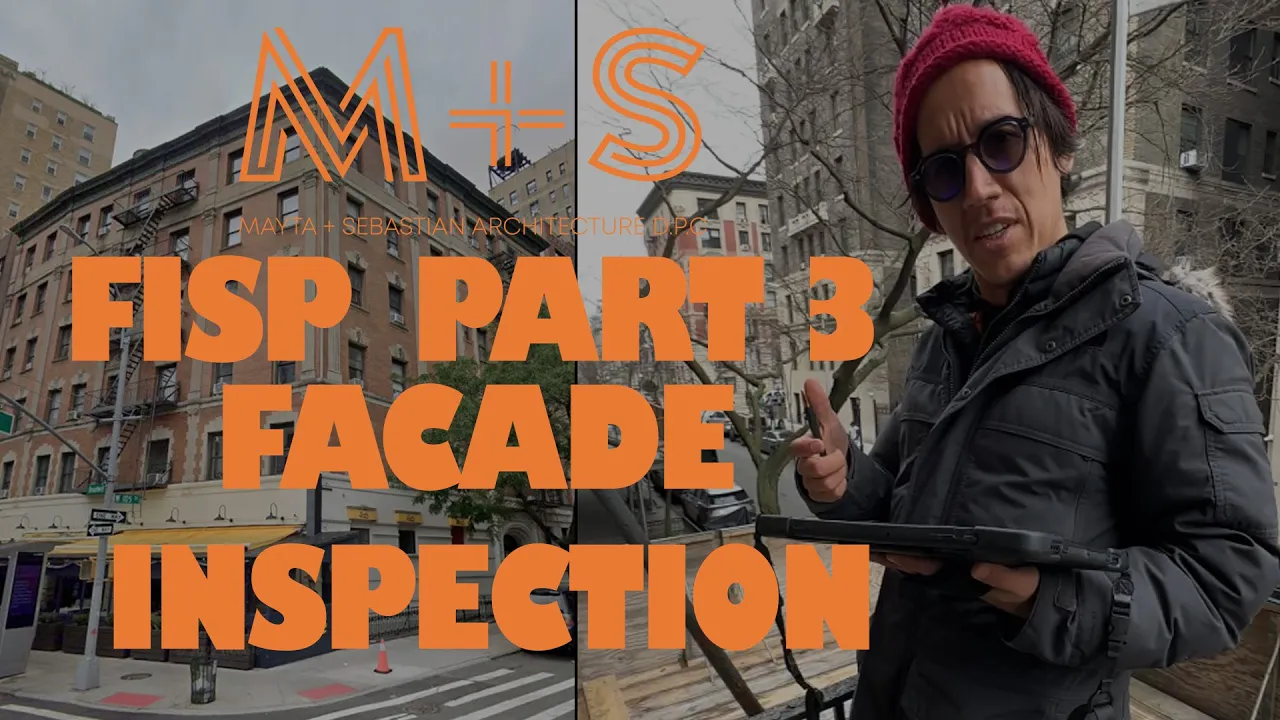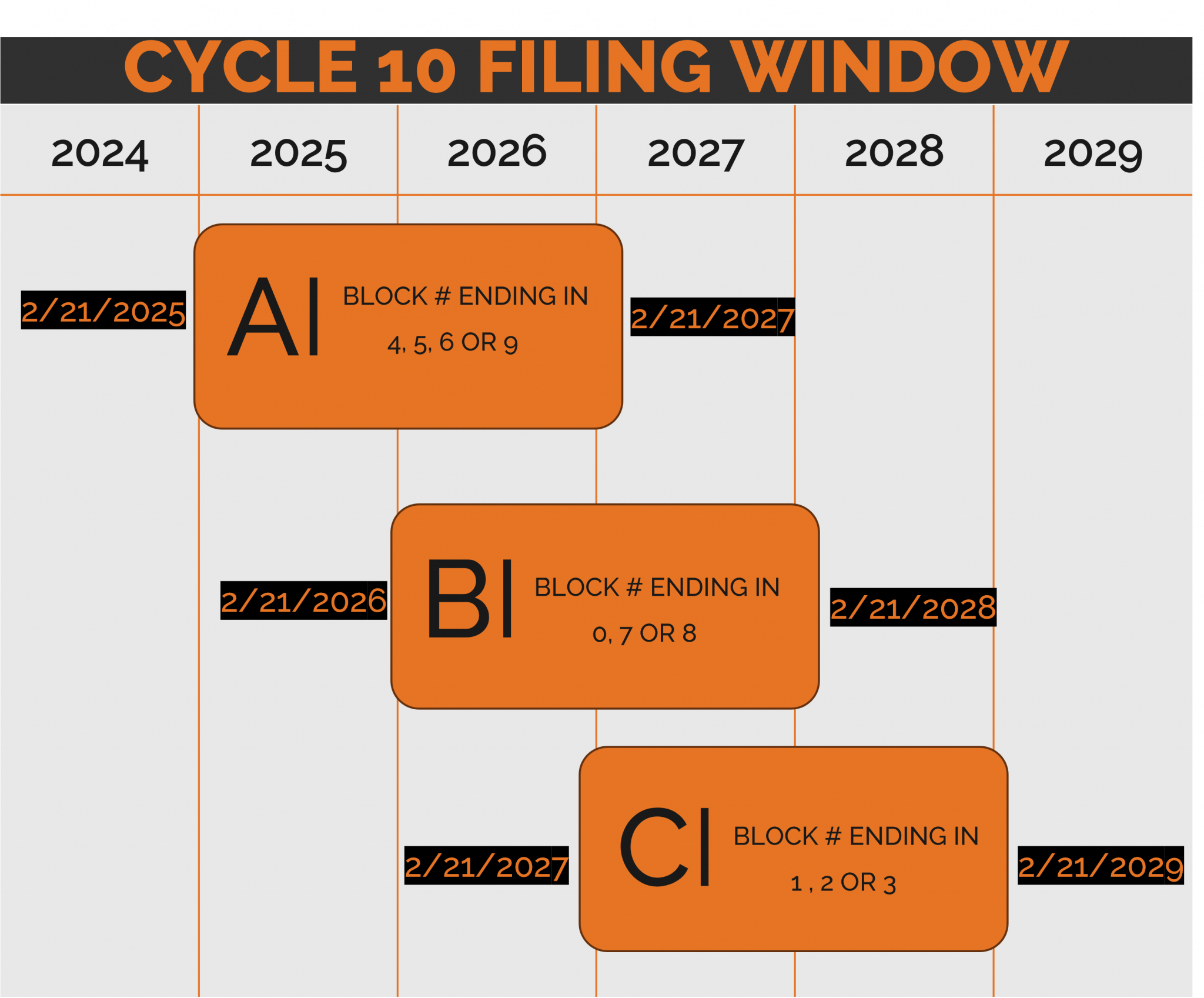FISP/ local law 11
Also known as NYC Local Law 11/98, the Facade Inspection Safety Program (FISP) is a law that requires the inspection of a building’s facades.Owners of buildings taller than six stories are required to have the building’s elevations inspected at least once every five years with emphasis given to the street-facing facades; and file a written report of the inspection findings with the New York City Department of Buildings (DOB)
Facade inspections must be conducted, witnessed, or supervised by a “Qualified Exterior Wall Inspector” (QEWI). The NYC DOB can certify Registered Architects and Engineers as QEWIs once their qualifications are reviewed by members of the the NYC Facade Unit.
The QEWI will determine the facade/elevations that will be subject to a close up review. At least one of the facades must be inspected hands-on from a scaffold (or balconies and fires cores if available); the other surfaces are typically inspected using high-powered binoculars; through windows, and/or from balconies and fire escapes.
The inspector documents the condition of the walls with notes and dated photographs; the written inspection report filed with the New York City Department of Buildings must include elevation and details photographs. The DOB launched a new system called DOB NOW SAFETY on September 12, 2016 that allows the QEWI to digitally submit the reports in a standardized format.
After the “Qualified Exterior Wall Inspector” (QEWI) inspects the building façades, he assigns one of the following categories:
- Safe (OK): No problems and in good condition, buildings do not require any façade work during this cycle
- Safe with a Repair and Maintenance Program (SWARMP) Façades designated as SWARMP require repairs within one to five years in order to prevent a potential unsafe condition, the sooner they are fixed, the better, both from a private cost and public safety perspective. QEWI indicates a recommended timeline for reports.
- Unsafe (UN): Problems/defects threaten public safety. Unsafe façades require public protection such as a sidewalk shed, and must be addressed within 30 days (the DOB’s default time frame for repairing unsafe conditions), or if more time is required to address the QEWI can file for 90-day extensions, which are granted as long as progress of addressing the “unsafe” condition is demonstrated.
- No Report Filed (NR): DOB categorizes a property as NR if no report was submitted.
Unsafe Conditions are typically items that could fall from a building):
- Loose bricks, mortar, or concrete;
- Cracked glass, terra cotta, or sandstone;
- Bulging masonry;
- Shifted parapet walls or stonework;
- Loose items (such as flower pots) on fire escapes or window sills.
Any Unsafe conditions observed by a QEWI or any Engineer or Architect must immediately be reported to 311, and a Notification of Unsafe Conditions known as FISP 3 Form , must be submitted to the DOB. Submission of a FISP3 form triggers a violation, and a DOB representative may inspect the unsafe conditions within 24 hours of notification.
Once a building has filed an Unsafe Report, the owner or manager must take the following steps:
Immediately coordinate the installation of a sidewalk shed or other means recommended by the QEWI to protect the public on all facades with unsafe conditions (or adequate fencing along facades not facing a street).
Submit to the DOB an extension request for repairs if the repair work cannot be completed in 30 days. The DOB typically grants a 90-day extension, which can be requested again as needed until the work is completed. As long as extensions are approved and maintained during the repair program, the DOB will not assess any fines.
Submit to the DOB a letter from an engineering/architectural firm stating the scope of work, timetable for repairs, and confirmation that the proper safety measures are in place.
Submit to the DOB a copy of the contract with a contractor hired to perform the necessary repairs.
After the unsafe conditions have been corrected, the engineer/architect administering the repair program will file an Amended Report with the DOB upgrading the building status to SWARMP or Safe. members of
What is considered SWARMP conditions?
SWARMP conditions are conditions deemed by the QEWI filing the FISP report to be Safe at the time of inspection, but at risk of developing into Unsafe conditions before the beginning of the next FISP cycle.
Examples include:
- Cracked or spalled masonry
- Deteriorated mortar joints and damaged coatings
The QEWI must list a specific deadline by which each individual SWARMP item must be corrected to prevent it from deteriorating into an Unsafe condition. If any SWARMP item is not corrected by the established deadline, the Department of Buildings can at its discretion downgrade the building’s status to Unsafe.
If any SWARMP item is not repaired by the time the next cycle’s report is filed, the building may be automatically downgraded to Unsafe, regardless of the actual degree of physical danger posed by the cited condition. Outstanding SWARMP items cannot be carried over from one inspection cycle to the next.
Deadline for conducting the facade inspections
In the first six inspection cycles, from 1980 to 2007, the DOB required all buildings to file their facade inspection reports in the same two-year window. To reduce the inspection, filing, and processing load, the DOB began staggering the filing deadlines starting with the last (7th cycle) in 2010.
For the current Cycle (Cycle 9), buildings will have overlapping two-year windows for filing. Buildings are grouped according to the last digit of their block number:
- Sub-Cycle A:
- Block numbers ending in 4, 5, 6, or 9:
- Reports must be filed between February 21, 2020 and February 21, 2022.
- Sub-Cycle B:
- Block numbers ending in 0, 7, or 8:
- Reports must be filed between February 21, 2021 and February 21, 2023.
- Sub-Cycle C:
- Block numbers ending in 1, 2, or 3:
- Reports must be filed between February 21, 2022 and February 21, 2024.
For the current Cycle (Cycle 10), buildings will have overlapping two-year windows for filing. Buildings are grouped according to the last digit of their block number:
- Sub-Cycle A:
- Block numbers ending in 4, 5, 6, or 9:
- Reports must be filed between February 21, 2025 and February 21, 2027.
- Sub-Cycle B:
- Block numbers ending in 0, 7, or 8:
- Reports must be filed between February 21, 2026 and February 21, 2028.
- Sub-Cycle C:
- Block numbers ending in 1, 2, or 3:
- Reports must be filed between February 21, 2027 and February 21, 2029.
After the unsafe conditions have been corrected, the engineer/architect administering the repair program will file an Amended Report with the DOB upgrading the building status to SWARMP or Safe. members of
Properties with more than one building
For properties with two or more buildings taller than six stories occupying different block numbers, the owner can file either of two ways:
- The buildings can be filed separately based on the last digit of their block numbers.
- The group of buildings can be filed together under the filing window for any one of the buildings. The DOB must be notified of this intent at least 180 days before the end of the filing window.
Note: Buildings that filed together for the 7th Cycle FISP must continue to file under the same window in subsequent inspection cycles.
New buildings
A newly constructed building is governed by FISP reporting requirements once five years have passed since the initial Temporary Certificate of Occupancy (TCO) was issued. An owner must comply with the first filing deadline for that property that occurs after the five-year TCO milestone has been reached (or the Final CO in the rare cases where a TCO was never issued).
Building with six stories plus cellar or basement
Many buildings, particularly in Queens and Brooklyn, have a Certificate of Occupancy that incorrectly lists the building’s height as six stories plus a cellar even though the building is actually six stories plus a basement or even six stories plus a full above-ground lobby level.
The distinction between cellar and basement is important. A cellar does not count as a story because more than half of its wall height is below ground level. A basement, does count as a story because more than half of its wall height is above ground. So a building with six stories plus a basement is considered 6½ stories high, which means a facade inspection report needs to be filed, regardless of what the says.
Height verification
A Height Verification Request Form can be completed by a QEWI, Owner and/ or Owner’s Representative and filed with the DOB to validate that a building is either above or below 6.5 stories in height.
FISP inspection report
Facade Inspection Reports must be filed no later than 60 days after the QEWI conducts the final inspection and no later than one year after the hands-on inspection. Building owners need to promptly approve, sign, and return reports to the QEWI for timely filing with the DOB to avoid the need for re-inspection.
Missed the inspection
A building cannot skip an inspection cycle, no matter how much time has passed since the deadline. If an inspection report has not been filed for a previous cycle, the DOB will issue a “No Report Filed” violation. Once the report has been filed, the DOB may then retroactively issue a base penalty

Sidewalk shed removal
A sidewalk shed installed along a facade with unsafe conditions must stay in place until either of two things happen:
The DOB accepts the Amended FISP Report, upgrading the building status from “Unsafe” to either “Safe” or “Safe with a Repair and Maintenance Program.”
A DOB inspector visits the property and agrees no unsafe conditions remain and authorizes complete or partial removal of the shed before filing and acceptance of the Amended Report.
Removing the sidewalk shed before either of one of these conditions is met can result in an $800 fine. If the shed has already been taken down and a DOB inspector subsequently determines there are still unsafe conditions at the building, the shed will have to be reinstalled. Since it costs significantly more to reinstall a shed than pay the monthly shed rental, it is much more cost effective to keep the shed up until the DOB officially accepts the Amended Report.
Difference between an Amended Report and a Subsequent Report
- An Amended Report changes the status of a previously filed Unsafe Report to SWARMP or Safe.
- A Subsequent Report changes the status of a previously filed SWARMP report to Safe.
DOB filing fees
The following filing fees are associated with FISP reports and applications:

(1) Failure to file. An owner who fails to file the required acceptable inspection report shall be liable for a civil penalty of
five thousand dollars ($5,000) per year immediately after the end of the applicable filing window.
(2) Late filing. In addition to the penalty for failure to file, an owner who submits a late filing shall be liable for a civil
penalty of one thousand dollars ($1,000.00) per month, commencing on the day following the filing deadline of the
assigned filing window period and ending on the filing date of an acceptable initial report.
(3) In addition to the penalties provided in this section, an owner who fails to correct an unsafe condition shall be liable for
a civil penalty as detailed in the table below, until the unsafe condition is corrected. Unless the Commissioner grants an
extension of time to complete repairs pursuant to this section, the penalties will be incurred as detailed in the table
below. This penalty shall be imposed until receipt of an acceptable amended report by the Department indicating the
unsafe conditions were corrected, the sidewalk shed has been removed and the associated permits are signed off with
the Department, including shed permits, or an extension of time is granted by the Commissioner.
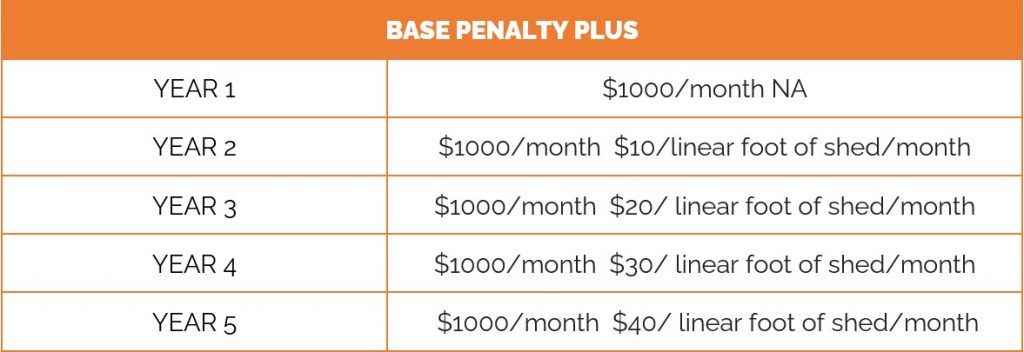
(4) Failure to correct SWARMP conditions. An owner who fails to correct a SWARMP condition reported as requiring
repair in the previous report filing cycle and subsequently files the condition as unsafe shall be liable for a civil penalty
of two thousand dollars ($2,000).
